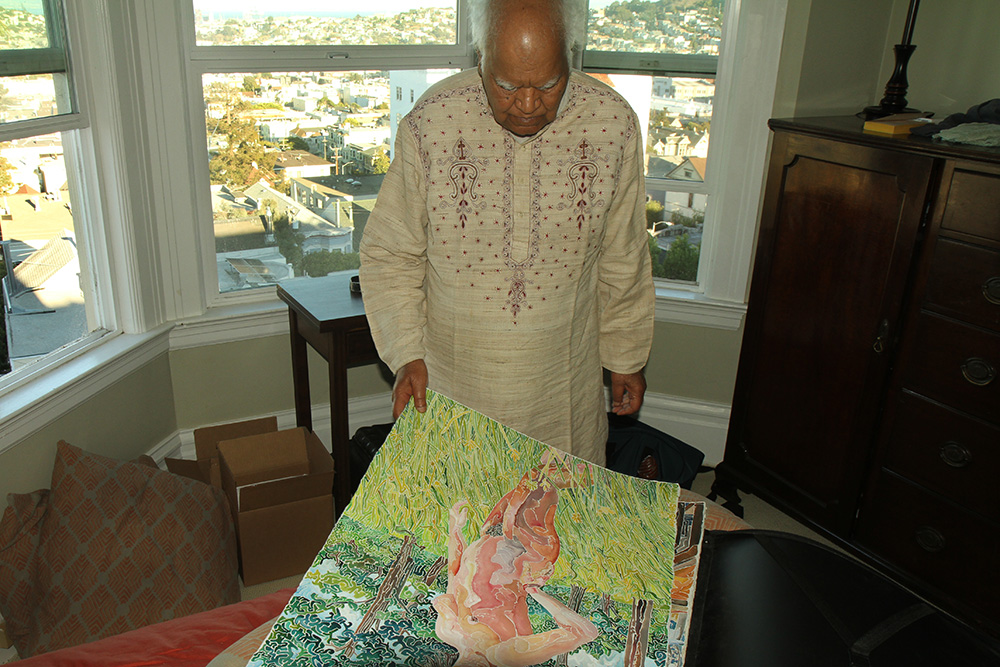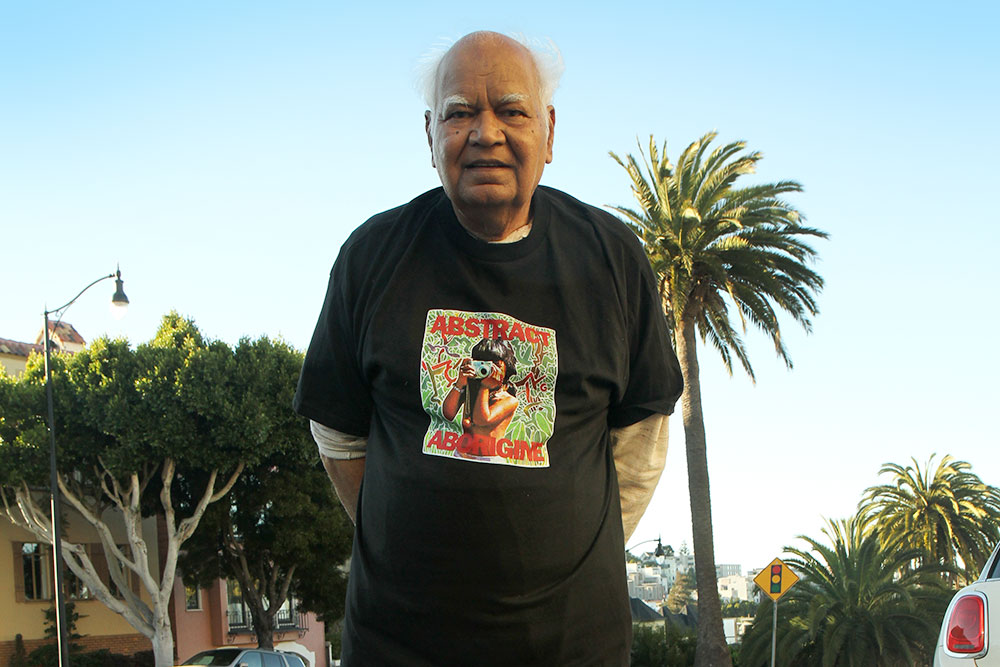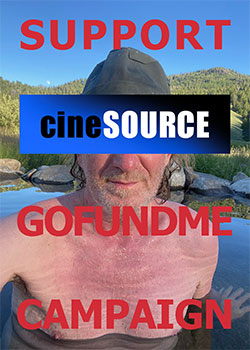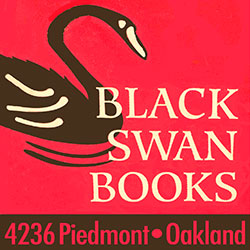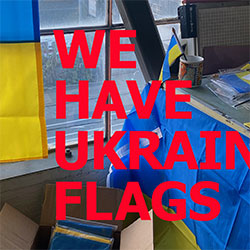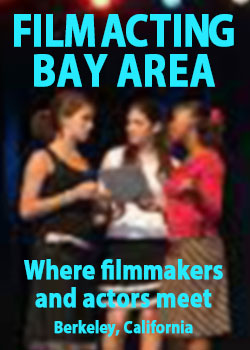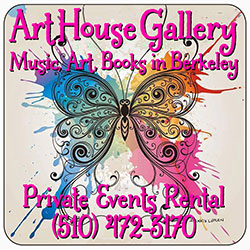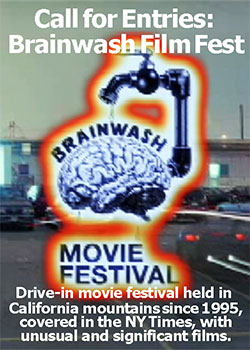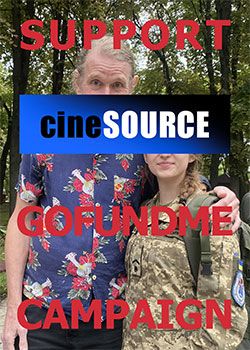Om Prakash Sharma [Part II]
by Doniphan Blair
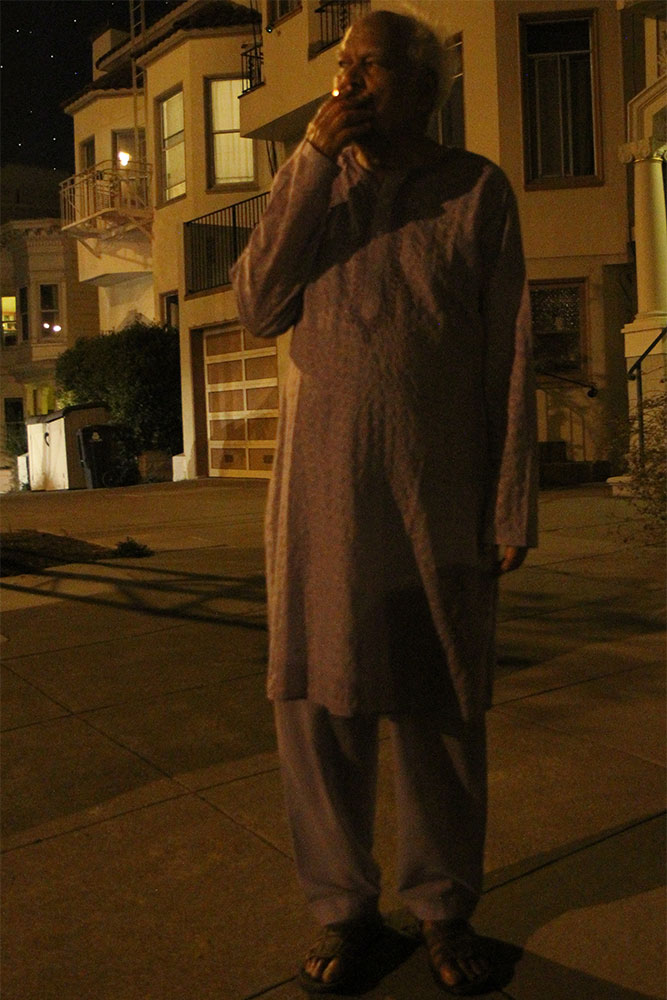 Om Prakash Sharma enjoys a meditative smoke, as he has for the last 79 of his 85 years. photo: D. BlairContinued from Om Prakash Sharma: Painting, Post-Colonialism and Tantra
Om Prakash Sharma enjoys a meditative smoke, as he has for the last 79 of his 85 years. photo: D. BlairContinued from Om Prakash Sharma: Painting, Post-Colonialism and Tantra
[We rejoin our 'Alt-Art' tour of San Francisco driving through the Marina Distrct.]
Om Prakash Sharma: The Italians came to New York.
You’re absolutely right, Om. The Italians came after the gold rush. SF has many powerful Italian families—number one, the Aliotos. He was mayor in the ‘60s. There’s the Molinari’s Delicatessen. This is nice to walk, take a coffee.
I met Andy Warhol. He took a fancy with my sitar playing. I remember one time you and Nick, [your] brother, got up on stage naked. Your mother was there and she was VERY ashamed!
Sanjay: But you [Doniphan] weren’t in New York at that time around Andy Warhol?
No, but my brother may have been with another [commune member named] Nick.
Yes, yes. They were on the stage. I remember, Kathleen was with me, she would know.
Then they came all, with chillums in their hands, to my apartment to make a recording of my sitar playing. I had a very distinguished lady sitting with me, from the United Nations, and here this group comes to my apartment.
They just sat down on the sofa and puff, puff, puff. I said, ‘Will you stop?’ ‘No!’ they said.
There were two beautiful girls, and they said, ‘You should record this music and they will use it in this play,’ so I made a recording.
I went to listen, with Kathleen, to how they were going to use this recording in the play. What they did was: they increased the speed of my playing so it sounded like ‘chi, chi, chi.’ They also had slides in the background.
And you and Nicky were going naked on the stage.
Really?
Sanjay: How come you don’t remember that Doniphan?
He is shy. He’s not telling.
Maybe my brother Nick was there. I wasn’t there but I will check with him.
[After checking, Nicholas Blair adamantly denies such a thing ever happening].
You just saw the cable car, right?
Very nice. I have the pamphlet of that program still. Spectrum, it is called.
It is quite possible that it happened, and that my brother was showing slides.
Yes, and you also started a band of yourselves [laughs]. I don’t know what was your objective doing that?
Sanjay: A family band?
Yes, we played quite a few gigs, I had four bands over the years. In your time, the band was The Cannibals.
I don’t remember. You invited me to a program but I could not make it.
When you told me about the band I thought, ‘How many things is this young guy doing? Every month something new.’
That was my problem. So now we are coming to another famous tourist site, the Lombard ‘curvy’ street. We taking a tour of the tourists.
I see.
Look at this poor guy, he has to live next to the tourists—he must hate it.
Sanjay: That curved road?
At night, it is beautiful, you can go fast—like being in Monte Carlo. San Francisco would be great for a road race. Now we are coming to my school [San Francisco Art Institute] and we are going to see—
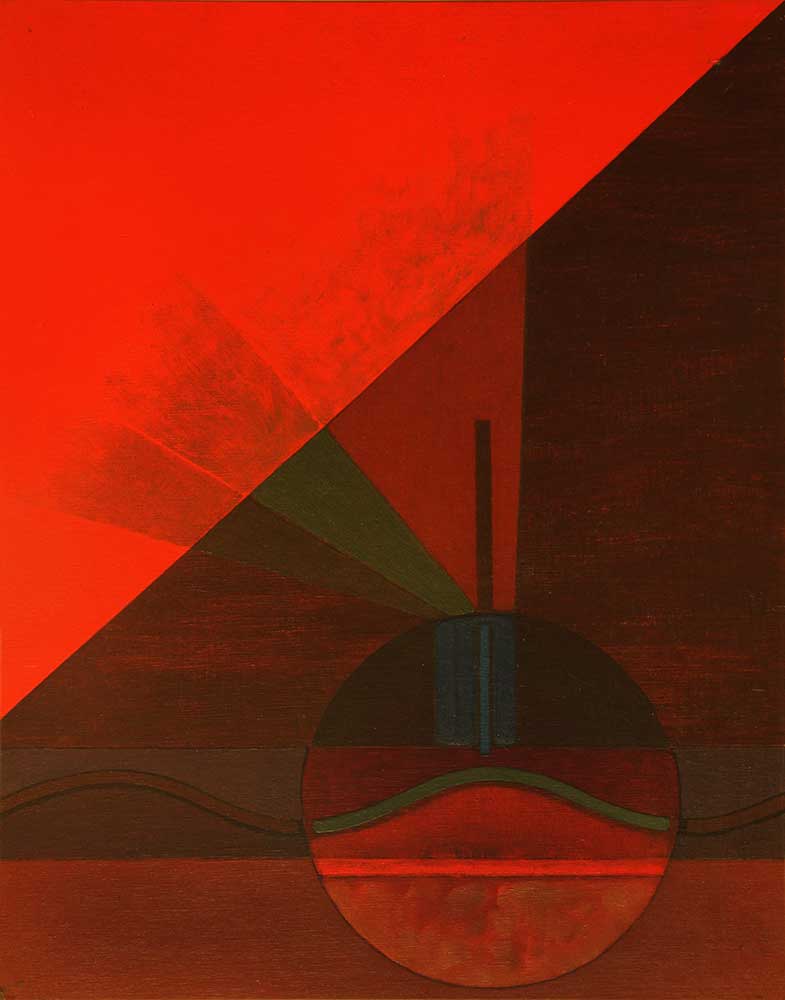 An early and smaller-sized Sharma painting, gifted to Ancient Currents for putting on his 1986 show. illo: O.P.SharmaSanjay: The murals.
An early and smaller-sized Sharma painting, gifted to Ancient Currents for putting on his 1986 show. illo: O.P.SharmaSanjay: The murals.
By Rivera. While he was painting them, he remarried Frida Kahlo.
Very nice.
I remember when I was dating Catherine, the daughter of the director of Pan Am. He was against [our relationship] and sent Catherine to Tasmania; then she came back to San Francisco to study art.
No doubt here at the Art Institute.
I will check with her.
How about this garden [in the school's entrance]? When I saw this the first time I said, ‘This is where I am going to school.'
[crowd noise]
Oh look, the Iranian film festival? You know any Iranian artists?
Yes. He studied with me for years, very devoted to me. He was Orthodox Muslim. He made paintings on Allah and all that, you see, which I didn’t like.
Neither did the other Orthodox Muslims, since they are not allowed to paint Allah.
He was living very nicely in India, with a descent flat and all that money. He invited me for dinner and there was a Palestinian boy, also an artist.
Oh, this nice [the view of the San Francisco Bay from the Art Institute.]
These are studios?
Yes, downstairs, we can visit if you want.
That’s OK. I want to visit a sound lab. I have a hard drive with all my music.
It is in bad shape?
No, good shape, but there are two questions I want to ask.
OK. That room might be right here. Excuse me gentleman, I am an alumni of this school.
Juancy: Hey, what up? [he later introduced himself as Juancy].
This is an old, old friend of mine I have known for 45 years. From India, a painter and a musician.
Juancy: Hello.
Student 2: Wonderful.
He has a technical question.
Juancy: OK.
I have this sitar recordings from 1966, recorded on LP in America, then later on [reel-to-reel] spools, and later cassettes.
Then I stopped playing and I thought, ‘Let me collect all my old recording,’ because my hands are weaker. I had a fracture here.
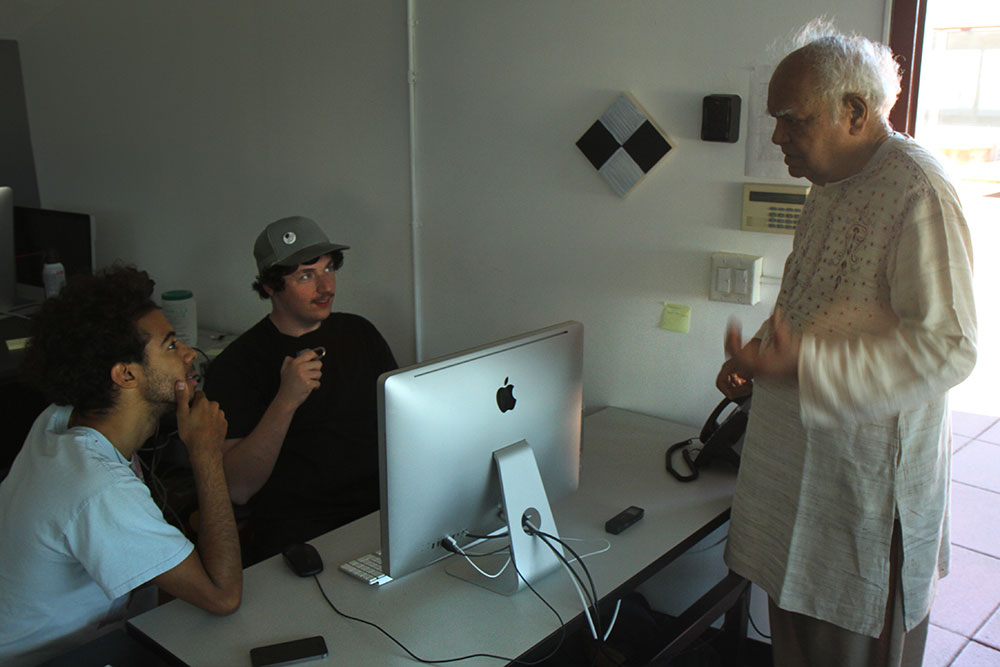 Sharma talks sound-recording shop with film students (Juancy, right) at the San Francisco Art Institute. photo: D. BlairJuancy: Oh man!
Sharma talks sound-recording shop with film students (Juancy, right) at the San Francisco Art Institute. photo: D. BlairJuancy: Oh man!
So I got someone to transfer them to digital format but I found so many unwanted sounds. So we edited it neat and clean but some of the recordings— there are about 93 of my playings in India, also Europe, Moscow and America—had two problems. One is: there is a warp; the other is distortion.
Is there any tool you can suggest I can buy and use in India with my sound engineer?
Juancy: Take the digital files and run them through a reel-to-reel. Then you digitize that. Cassettes, or analog, have this great quality of mastering themselves.
Mastering themselves? That sounds like a great philosophy—
You are saying transfer my digital CDs back to cassette and—
Jauncy: Then back to digital!
Give me your email so I can—
No, no—hello, hello?
I was in London before I came here and I found a filmmaker. So I gave him my CDs, all 93 raga pieces. He also used this word ‘analog’. Can you write it down?
I will remember: transfer back to cassette. We will keep in contact—what is your name?
Juancy: Juancy.
Juancy, this is Om.
After I transfer to digital, is there a way to remove the warping?
Juancy: That is complicated; that would need ProTools.
The notes are perfect but when the sound comes out, it reverbs.
Juancy: They have plugins you can use, ‘de-reverb.’
I had to sit with this engineer. He said, ‘I am using ProTools 9 but they have come out with 12.’
Juancy: 11, I think.
11? You think it is an improvement on 9?
Juancy: If you know ProTools, it won’t change much.
My question is: Will the newest ProTools have something additional to remove the reverb?
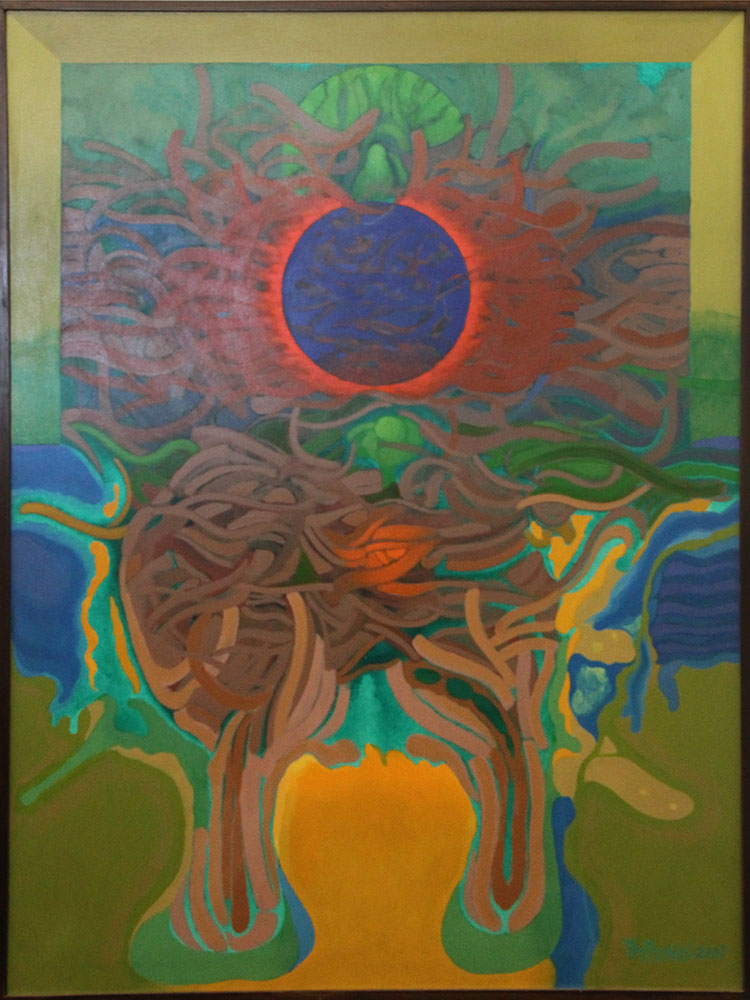 A striking organic-style Sharma from the recent Marin Community Foundation show, painted around 2014. illo: O.P.SharmaJauncy: I doubt it.
A striking organic-style Sharma from the recent Marin Community Foundation show, painted around 2014. illo: O.P.SharmaJauncy: I doubt it.
OK. Thanks Jauncy. We will be in touch by email. Om, we better keep on, if we want to get back in time for dinner.
[We thank the students and head out.]
This is a very nice school, why don’t you teach here?
You need a masters degree to teach here.
My brother got a masters here in two years—without a BA. The teachers liked him. I went here for 17 years took tons of classes but only got a BA. The teachers didn’t like me, they even wanted to deny me the BA.
That doesn’t matter: Just apply for a teaching job.
In 1976, I was invited to a conference of art teachers in Chicago. I drove with Kathleen [from New York], it was January. I had fever [but] she said, ‘No, your were invited and we have to go.’
[We enter SFAI’s Diego Rivera Gallery with the famous murals.]
I have seen better Rivera murals in Mexico.
Where is the bathroom?
[I take him to a facility downstairs.]
This is the old monastery bathroom—like going to India in here.
[laughs] Yeah.
[Back in the courtyard]
I was driving [to Chicago] with Kathleen in the snow and you know who was with us? [The Abstract Impression painter] Philip Guston’s son-in-law—I forget his name.
We were driving to Chicago and Kathleen shouted, ‘See Doniphan, see Doniphan?’
What?
Yes. Ask her. I never tell lies.
Om, whatever you tell me, I believe you.
The thing is I was so sick: I had 102, 103 temperature—it was only through Kathleen’s efforts that I managed to take that junket.
But I was thinking, ‘How could [Doniphan] be here, on this screwy road, trucks lying upside down?’ We had snow tires—nothing happened to us.
She said that she thought she saw me [hitchhiking] by the side of the road?
Yes, yes. And she wanted him—whose name I forgot—to stop. Actually [the son-in-law] introduced me to Philip Guston in New York when I had a big show. Phillip became a friend of mine.
Nice, nice.
The first thing I did when I got to Chicago—we stayed in a big hotel, with all the art teachers from America, even Hawaii—I went to find some medicine for my fever.
 The girlfriend of an old friend of Sharma dances the Bharatanatyam at a dinner held in his honor at his son Yogesh's Dolores Heights apartment. photo: D. BlairThey said you have to get a prescription and it will cost $150. But he said, ‘You are a young man, you are strong, take 5000 mg of Vitamin C and you will be alright.’ I had that Vitamin C and the next day I was OK.
The girlfriend of an old friend of Sharma dances the Bharatanatyam at a dinner held in his honor at his son Yogesh's Dolores Heights apartment. photo: D. BlairThey said you have to get a prescription and it will cost $150. But he said, ‘You are a young man, you are strong, take 5000 mg of Vitamin C and you will be alright.’ I had that Vitamin C and the next day I was OK.
Nice.
I had to speak about art education in India and the proportion of how many applicants apply to the College of Art to how many students are admitted. They just wanted the information on the system of art education in India, by and large.
They said, ‘This is the exact proportions we have in America: ten students apply, one is admitted, and out of ten one is able to become a fine artist, a freelance artist, and the rest go for art teaching or advertising’—something like that.
I said, 'That was exactly the situation in India.' [laughs]
Sanjay [entering]: I was just checking out the studios. There is an art studio; anyone can come and draw; they put nude models up. There is a student working.
Oh, nice.
This is what I did in the College of Art—against all rules, I allowed anybody, even an architect, or diplomat, or a geography student, to join College of Art as what I called a ‘non-college student.’ They can come anytime and attend any studio, any class.
Did you have nude drawing? That is always controversial.
Yes, yes, sure. I had to request the commissioner of the police to send some models from those women, who were arrested for some crime or something and wanted to earn some money—under my guarantee no one will tease them or touch them.
[We return to the car and start driving west.]
When did you first go to Russia?
The first time I was there was 1954. Three times I was in Moscow.
Here is the [Marina] Safeway, where they brought Russian diplomats in the ‘80s: 'people-to-people diplomacy' it was called. They claimed that, when they showed them some products, like jam, and converted the prices from dollars to rubles, the diplomats would sometimes start crying.
Sanjay: Yes?
They assumed it had to be very expensive because it was so nice but food is cheap in California.
They had the America’s Cup Race here last year. It was fabulous, unbelievable, the big boats.
Sanjay: Yes, magnificent.
But Om, you were telling us about Moscow. That must have been strange, going there from India, eh?
Yes. The first time I was a guest of the Russian government. I was part of delegation involving filmmakers and some politicians—
There is Golden Gate Bridge! Our next stop.
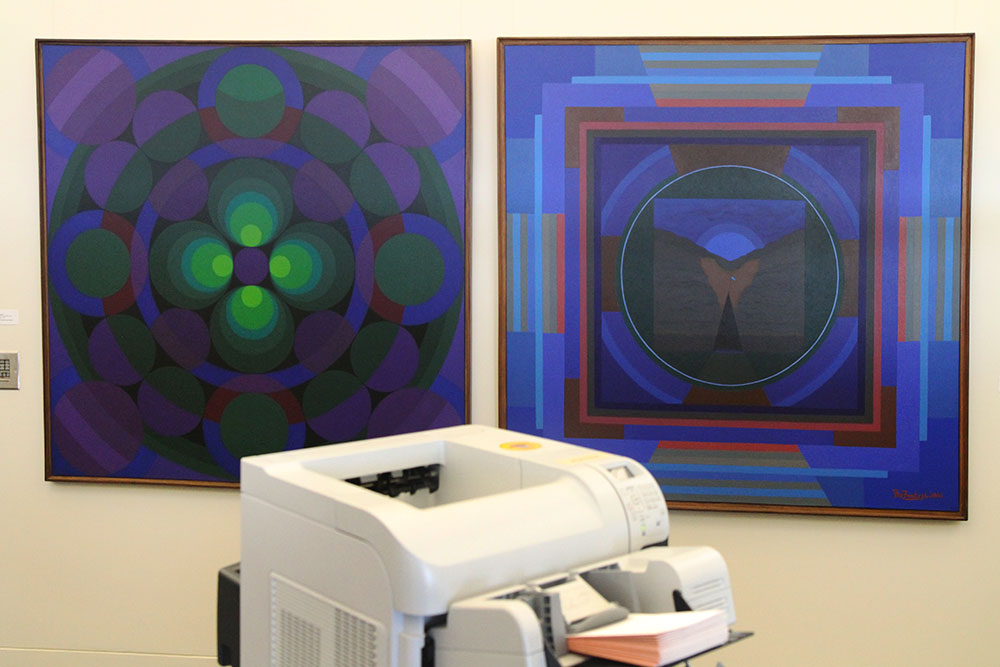 Another pair of subtle Sharmas on display at Marin Community Foundation show, fall 2016. photo: D. BlairI have been there, twice.
Another pair of subtle Sharmas on display at Marin Community Foundation show, fall 2016. photo: D. BlairI have been there, twice.
If you don’t feel like it, we can go to another place—so you were in Russia?
I have been there, to all places, starting with Tashkent.
Tashkent, my god!
Then we went to Almaty, Kazakhstan; from Almaty, we were taken to Moscow; from there to Leningrad. It was June so there was no night—day and night, same.
Since one of our delegation was a filmmaker, we went to film studios, met actors and directors and all that. Every one is equal: directors same pay actors, equal facilities, no star system. The driver had the same salary as the director of the film.
Right.
Brezhnev, the president of Russia, lived in an apartment next to which I had dinner with one professor. And everywhere, there was a spy, a car. In the front, there will be an escort car and behind, a spy.
I was very annoyed with this. I was watching from the window from my room. You know, the hotels were ugly but each hotel was like a city. And half of these hotels were prostitutes—achhh! So I looked out of the window, I remember, and I saw the spy car.
Right in front?
Yes! ‘What is up? We are not politicians. We are artists, filmmakers, writers—one poet,’ I asked the tourism fellow. He said, ‘He is not a spy. It is for your security.’ [laughs]
There was another guy, our interpreter, George, very nice young man. He was devoted to me and he spoke very good English. Tall, handsome boy but his problem was drinking. [laughs]
The Russian problem.
Of course, all over, smoking and drinking: every girl, every man, every old woman, every one smoking, drinking vodka.
In the night, he was so drunk and one of our delegation, a communist from Mumbai, he went with a prostitute. For that, George was arrested. Because he was drunk and he was misbehaving.
We had a farewell party. I had a talk on the radio [and], when I finished the radio talk, for which I was paid some rubles, I saw him standing outside the radio station.
I said, ‘What is the problem, I don’t see you.’ ‘Oh well, they don’t like me and I don’t like them.’ [laughs]
I tried to help him out. The head of my delegation was Mr. Koch, a Kashmiri, the Minister of Tourism. I said, ‘Look, can we save this boy?’ He said, ‘You can’t do anything in this country. Once the KGB takes over, nothing can happen, this boy is finished.’
The next time I went [to Russia], another invitation, a girl, who was from Russia and was my student in the College of Art [and then] went back to Moscow—she became my interpreter.
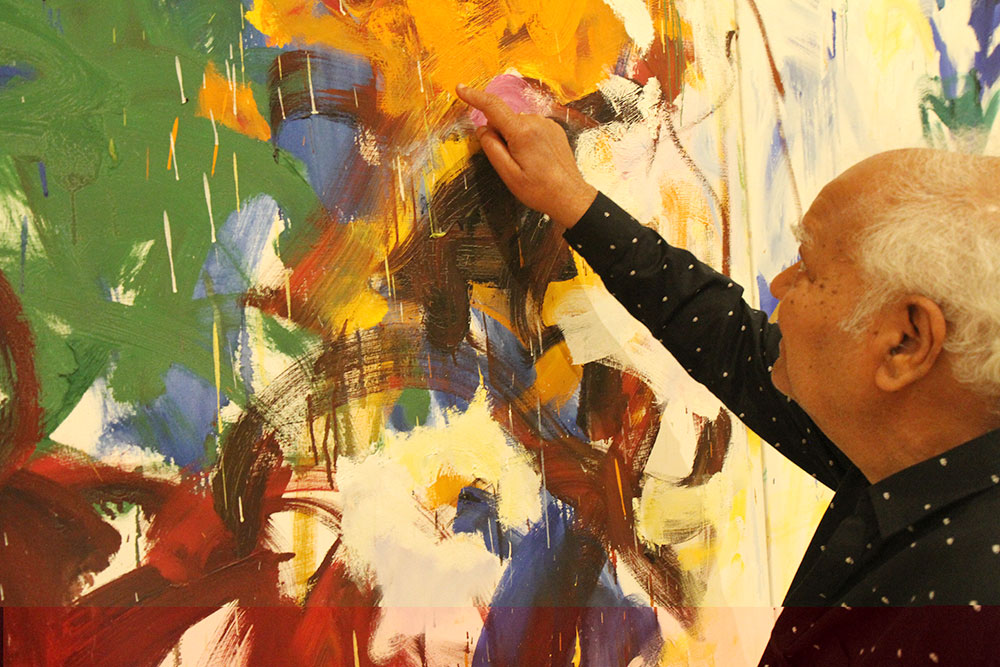 Sharma close reads the brush strokes of a Joan Brown during his visit to the SF MOMA. photo: D. BlairShe was actually married before she came to India, but she divorced her husband in Moscow. We had a relationship with letters—every letter was censored.
Sharma close reads the brush strokes of a Joan Brown during his visit to the SF MOMA. photo: D. BlairShe was actually married before she came to India, but she divorced her husband in Moscow. We had a relationship with letters—every letter was censored.
How about when you met with the Russian artists, were they censoring themselves?
I met quite a few artists, sculptors. Good friends. They came to India; they came to my college; they wanted to make a statute of Mahatma Gandhi—which they did. I was the advisor to approve the statue but the art commission didn’t allow Gandhi to go up in India Gate. They said, ‘The College of Art should have it.’ I said, ’No, I don’t want it.’ Some other place took it.
I went to their studio and the whole night… [drinking motion]
Vodka?
That is another world, altogether.
It’s amazing how creative these Russian artists were, even under bad times.
You have no idea. Underground, you see, and no support.
Those who painted the ideology of the communists, they were given dachas, you know? It is the big country house, with all facilities, gardens. We were taken to two or three dachas of writers, some artists, one time an old lady who had been to India.
So Elena, my [translator] friend, would come to meet me in the hotel. After my interpretation is over, dinner is over, she will go back to her place in the night and the cold. Then she would sneak into my room, avoiding all the prostitutes on her way—what a brave woman. Then at four or five o’clock [in the morning] she would go back.
She is still alive and is the head professor, head of ancient art in Moscow University. She knows seven languages. Her father was the ambassador of Russia in Japan in WWII and she was born in Tokyo. Brilliance—absolutely. And what a grace, and very quiet, and a very sweet person to talk to. Good conversationalist—I loved her like crazy.
[Another time] I went to Moscow for my exhibition at a private gallery. Then I decided to go to Mongolia—I always wanted to go to Mongolia—from Moscow. I thought I would take a train crossing the Siberian desert, seeing the entire country.
[We arrive under the Golden Gate Bridge.]
Well, what do you know—the Golden Gate Bridge!
I am not ready to go out again—it is difficult to walk for me.
So I went to Moscow; I picked up Elena. [laughs extensively] ‘Come with me to Mongolia!’ She said, ‘I have a whole department, I am running.’ I say, ‘I don’t care!’
We decided not to take the train. To save time, we went by air—but what a country, Mongolia, my god! You can’t believe the life, the atmosphere. The Gobi Desert: miles, miles.
You guys getting hungry? I wouldn’t mind a pekora right now.
[A beautiful woman jogs in front of the car.]
I believe, when a girl is crossing, always stop the car to let her go by.
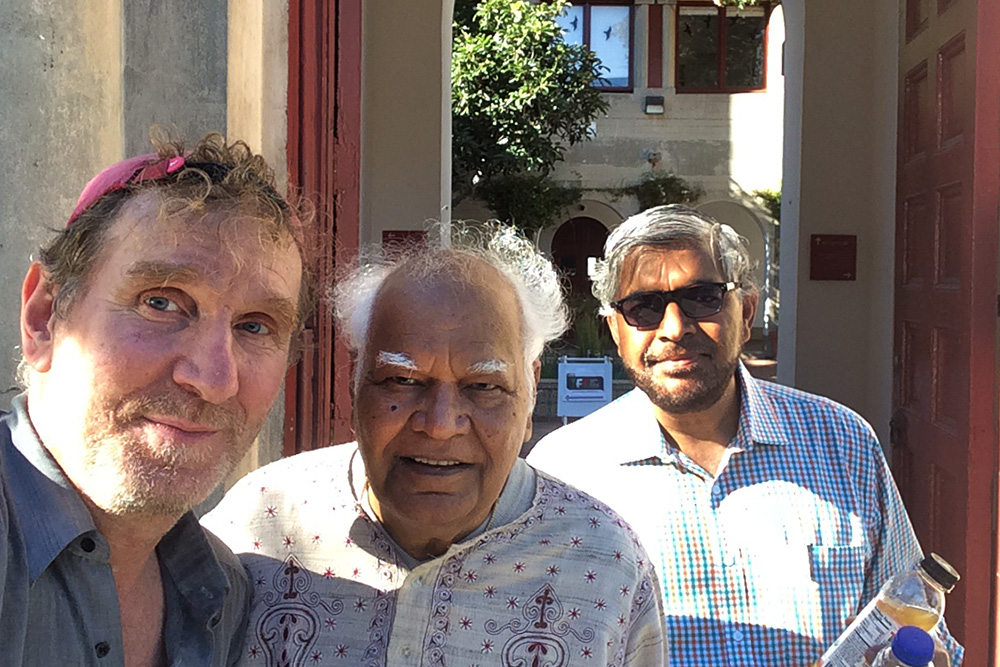 Author D. Blair, O.P. Sharma and son, Sanjay, at the San Francisco Art Institute on their cineSOURCE tour. photo: bystanderNice scene.
Author D. Blair, O.P. Sharma and son, Sanjay, at the San Francisco Art Institute on their cineSOURCE tour. photo: bystanderNice scene.
She thinks I am being polite—
But you are watching her! [laughs]
Detour? I don’t know what to do. You have to see the Haight—you don’t care about the ocean, right.
I have seen the ocean.
You have seen MANY oceans! We have to see the Haight, where the hippies were, that is critical.
Sanjay: Yes.
Anything else?
Sanjay: No.
Detour. I can always get out the GPS but that is cheating, right Sanjay?
Sanjay: That’s exactly right.
GPS is for amateurs. If I can’t find my way, they should fire me. This all used to be Army barracks, for the officers. Look, here are the burials.
In Leningrad, I saw these burial grounds. In the 1940s, you know about it? What a fight they had, they never surrendered. Stalin and Hitler had a pact.
The Molotov Ribbentrop pact.
Sanjay: But you were not in Russia in WWII.
No, but I saw the ground where they were buried, one on top of the other, one top of the other, thousands of Russian soldiers. I saw people going into the burial grounds and offering bread.
Here we have a beautiful view. Way over there is Yogesh’s house, in the Mission. Between we have the Golden Gate Park. Over here, we have some nice beaches, even some nude beaches.
You have every nationality.
It is a very multicultural city. Only New York and few other places in the world have more languages in the schools. Sadly, the tech boom it is pushing out the poorer people.
It is a young city. It has the advantage of not being too established. If you have an old city, the rich people have been there for a long time.
What do you mean, a young city?
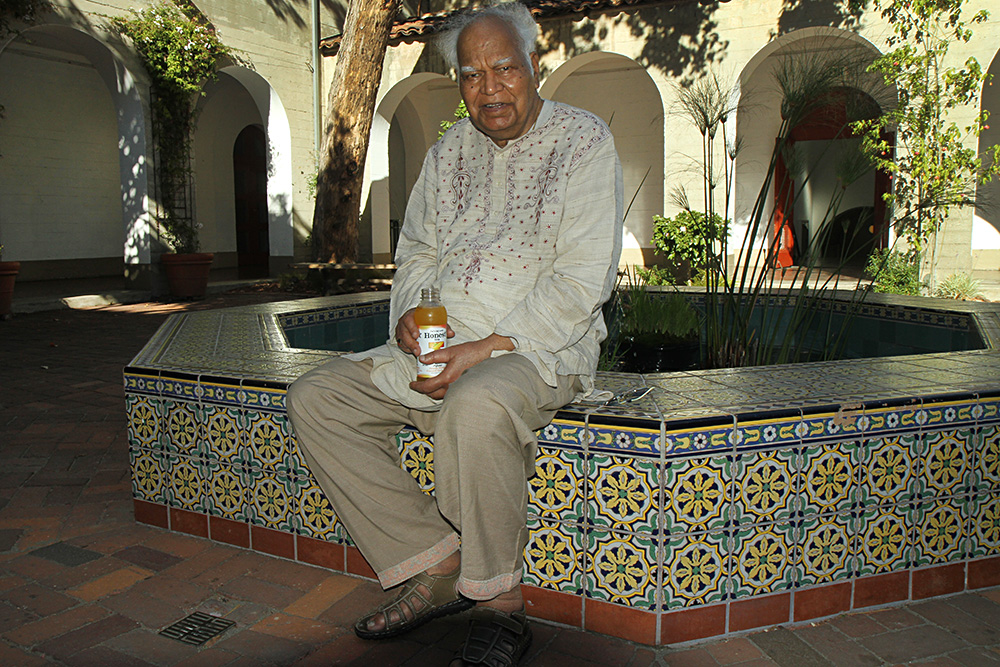 Sharma takes a sit-down cigarette break at the SF Art Institute Moor-style courtyard on his cineSOURCE tour of San Francisco. photo: D. BlairIt is only about 180 years old.
Sharma takes a sit-down cigarette break at the SF Art Institute Moor-style courtyard on his cineSOURCE tour of San Francisco. photo: D. BlairIt is only about 180 years old.
American itself is only 300 years—
That is true but New York is 400 years old.
350. [To be precise: The Dutch ‘bought’ Manhattan in 1609—408 years ago.]
Those years in Russia, the churches were totally discarded, nothing. No activity. Then when I went there in 2004, for my exhibition, I was invited to attend a wedding in an Orthodox church, so they opened their activities. When I went, I had a concert, a live recording in the Museum of Music in Moscow.
By the way, this is Golden Gate Park, the biggest park of any city in the world.
I see.
So let’s get back to the history of Tantra. Where is Tantra today in India?
Nowhere!
Except some, you know, mysterious people. Some Tantrics continue the rituals and other things, mostly in the cremation grounds or at a [rural] cottage. ‘Come visit the baba.’ They claim to cure diseases or madness but they are all frauds.
They are all fake; they are arrested for rapes and fraud; but they are there. They have some kind of reckless charisma about them because of their dress, living nude in a cave or some forest, or on a cremation ground. Poor people, they go for help or cure for disease. They take advantage of that in lots of places but people are learning that they are frauds and fakes.
There is no legitimate Tantric teacher in all of India today?
Teachers of Tantra, on the philosophical level, they are there. Tantra is also part of Buddhism, because a parallel [adoption of Tantric principles] was going with the Buddhism [as with Hinduism]. But Buddhism also became very rigid about their rituals.
Tantrics liberalized themselves, you see. They gave equal rights to women—number one, I respect that. Also, they didn’t have any phobias about sex and sexual practice. They were very liberal people; they had no caste or prohibitions, like gender. Very free. One of the freest people in the civilized world.
They were very pro art.
No, they were not actually artists. But, you see, what they did—meditation—was one of the very important aspects of Buddhism as well as Tantric culture. Every place Tantrics got together, they would meditate. So they used to make charts, drawings for meditation.
About what century?
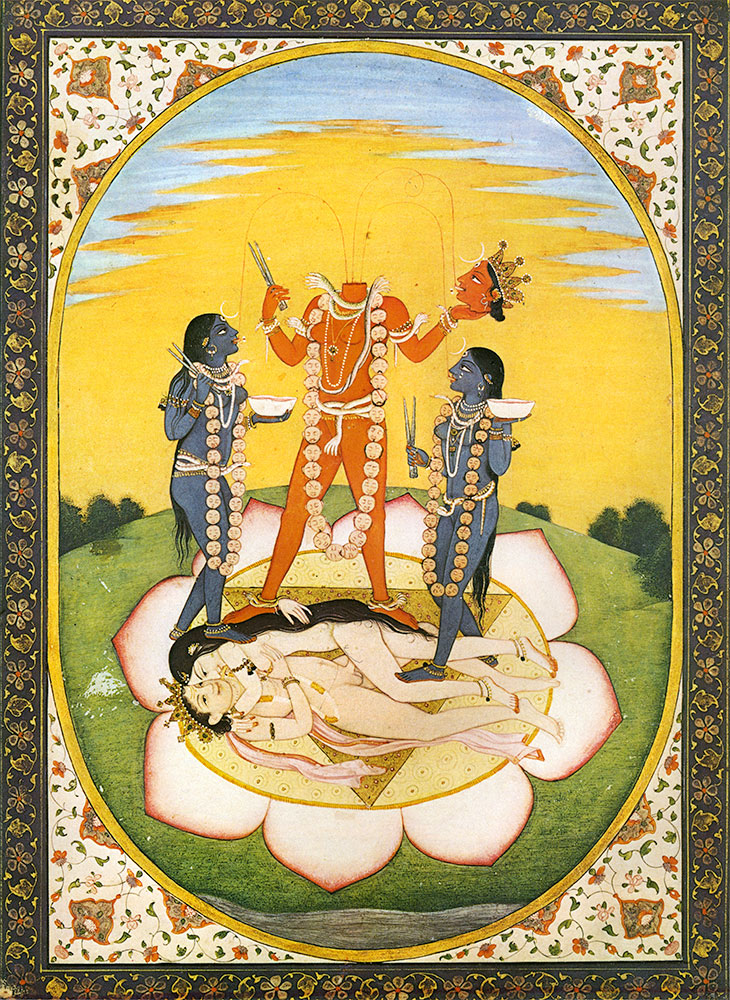 Tantric shaman arising from the cosmological 'original couple,' Kangra, 1800. illo: courtesy Philip RawsonFirst century AD or even before. [Tantra] was a sort of sidetrack for those people neglected by the main society because of the cast or creed or ideas [that] were too radical. Hindus won’t accept them and Buddhists won’t accept them. Slowly, slowly Buddhism became very dictating: Mayahana, Hinayana, and all that.
Tantric shaman arising from the cosmological 'original couple,' Kangra, 1800. illo: courtesy Philip RawsonFirst century AD or even before. [Tantra] was a sort of sidetrack for those people neglected by the main society because of the cast or creed or ideas [that] were too radical. Hindus won’t accept them and Buddhists won’t accept them. Slowly, slowly Buddhism became very dictating: Mayahana, Hinayana, and all that.
Then the Tantrics came up. I admired them. They talked about the universe; they talked about cosmology; they talked about medicine; they talked about art; they talked about music.
Here is Haight Street, the epicenter of the hippies. When they put in the MacDonalds [fast food restaurant on the corner of Golden Gate Park], there was an outcry, ‘A MacDonalds!?!’
It would be good if we could find a ‘head shop’ where they sold incense. India had a lot of influence on the Haight.
Yes, yes, including hashish and marijuana?
All that too, but mostly incense, shirts and—
Beads and bedspreads?
Yes. Sanjay keep and eye out. Ahhh, the Tibet store. You want to get out?
No.
In its day, the Haight was very colorful. Every store would have been a little restaurant, or an India store or a book store. India gave so much [to the hippies].
Yes, India has so much of history, so much of culture, so much of beauty.
Japan has promised to make Varanasi a beautiful ancient city. They will fund everything. [Prime Minister Narendra] Modi went to Japan and became friends with Prime Minister Abe. Then Kyoto adopted Varanasi and Varanasi adopted Kyoto.
A very difficult job [for the Japanese]. The Hindus, they just love filth, they just love shit around everywhere.
They probably don’t love it but it is hard to get rid of because Varanasi is a very old city.
Yeah. Oldest city in the world.
So they have that disadvantage: the oldest rich people, the oldest sewers.
Yeah. Modi commented to that because he was elected from Varanasi.
Oh was he? What do you think of Modi?
He is not a politician, number one, he is a statesman. In country like India, people love politicians and hate statesmen.
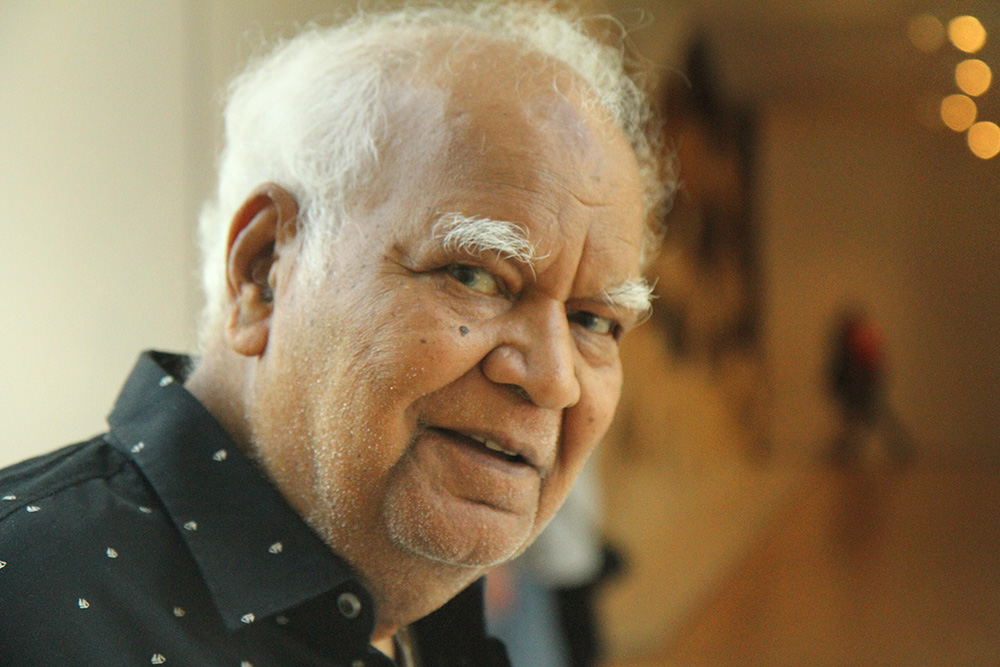 With his good humor and sense of adventure, still robust at 84, Sharma leads the way into the SF Museum of Modern Art. photo: D. BlairI support Modi. The thing is he can’t do what he wants to do because everybody is deep into corruption; all politicians are corrupt; all of them, one to a hundred. They are not going to let a man like Modi affect their thrones.
With his good humor and sense of adventure, still robust at 84, Sharma leads the way into the SF Museum of Modern Art. photo: D. BlairI support Modi. The thing is he can’t do what he wants to do because everybody is deep into corruption; all politicians are corrupt; all of them, one to a hundred. They are not going to let a man like Modi affect their thrones.
In the last two-and-a-half years of his rule—not one case against his government for corruption! He is so tight on each and everyone.
[But] how to get out of this deep-rooted corruption, from the lowest level to the highest level? The digital system is going to take care [of that]. The middle man going out of the system, one by one by one.
But India is doing pretty great isn’t it, with the new tech boom?
Oh yes, promising.
But it will take much longer to see the change. Modi doesn’t like to wait [laughs]. Can you believe this man: works 18 hours-a-day, nonstop; calls meetings at 12 o’clock in the night; bureaucracy on their feet—at anytime! He is very well prepared; he has a system.
By the way, this is Castro, the gay neighborhood—see the rainbow flags, very powerful in the city.
You don’t think Modi is a little too Hindu nationalist?
Well, he cannot avoid this because the Hindus elected him. He is depending on them. If he is voted out, all his chances are destroyed to do anything for the country.
He has to tolerate these bloody jokers. Of course, he is giving them reprimands, telling them, ‘Stop!’ One day, he said, ‘If you have to do this to people’—trash them because of caste, or creed—‘shoot me. Kill me.’ The prime minister of a country saying: ‘Kill me!’
They think he is their prime minister whom they have elected, so they can do what ever they want. They treat Muslims very badly. He says, 'If you touch them, before you kill them, kill me!’ What can he do more then that?
Really?
I think it will work, but it will take time. The moment these jokers are caught, 10-12 people are arrested and sent to jail, then the effect will show. It is already happening, quite a few people are in jail.
And this problem of Pakistan, my god!
Is that getting any better?
No way.
Same as 1948?
No!
The Kashmiris are, for the last 40 years, depending on India government support. They believe that the more noise they make, the more they show their sympathy to Pakistan, the Indian government will keep on feeding them. They are so bloody selfish.
Sanjay: We are parking?
We are stopping for one minute, if you have any secret thoughts about the Tantrics, say it now.
You see, my [car] door broke today. That symbolizes that our friendship is unbroken—in a Tantric way. [laughs]
OK. [laughs] What is he doing?
Sanjay: He may have to meet someone. He’s pretty young, only 62.
I see. He looks young, very active, sharp mind, very observant.
[I return] Did you say something about Tantra?
Sanjay: No, we said something about you.
Something nasty? [laughs]
That was the house of [another old friend of Sharma] Nick Soter. I thought I would surprise him by dropping by but he was not home. Maybe he can say ‘Hi,’ later.
My concern about Tantra is, when I came to India from America, as I said yesterday, I was totally confused about what to do. I had seen so much of art in America and Europe and Rome and Athens and Cairo, everything, great art.
I said, ‘What can I do now. I don’t want to waste my time repeating what already has been done. I have to do something new.’
And slowly, slowly the geometry [painting] came. When I started the geometry [painting], I got a lot of criticism. They thought my art had become very stale, emotionless, un-figurative, non-objective etc, etc.
Two or three things helped me: My dialogue with and admiration for [Mark] Rothko. And the other person I admired was Kazimir Malevich. Have you heard of him?
Ahhh, that man, in 1910-12, he created the square [paintings], you know. And he said, “I am fed up of the power of objectives in art.’ That supported my line of work.
Plus Tantra came on the scene. I was already doing these things but I got a lot of inner force [from it]. I liked the discipline, the way, graphically, they sorted out the problem of composition, design, and placement and balance and centralization—amazing!
Although they were not art, they were only illustration, the graphic thing [was good]. That helped me to continue with what I was trying to do. But I am not interested in their rituals. I went once, with some of my admirers, to some cremation grounds to spend the night there.
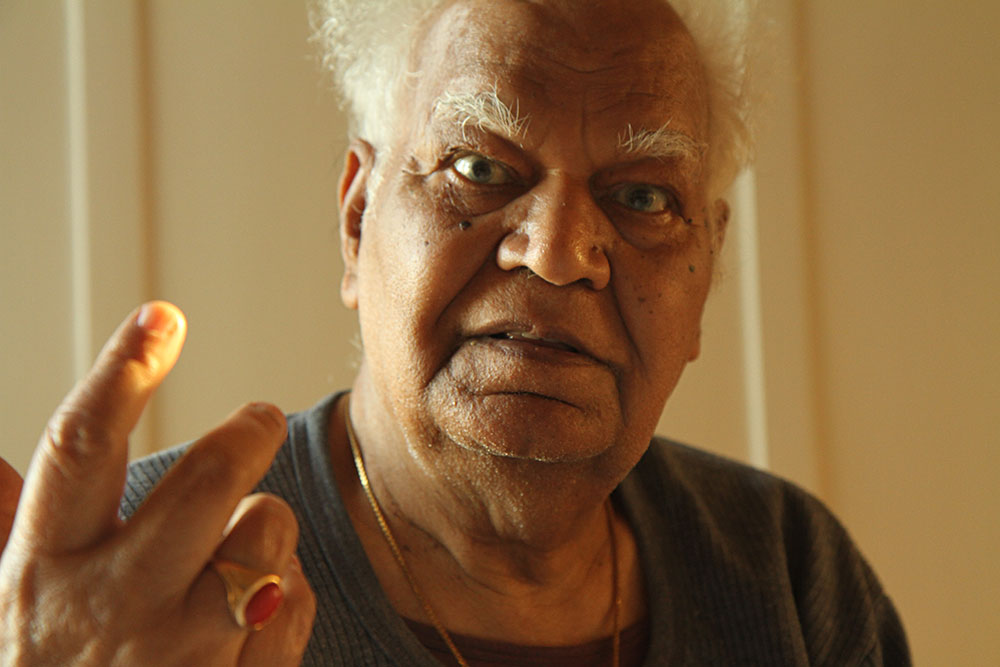 Sharma making an astute point about Blair's artistic practice, while nature, in the form of an errant light beam, highlights it. photo: D. BlairI saw them drinking and smoking. I didn’t like the whole atmosphere. If that is Tantra, the hell with it, you see!
Sharma making an astute point about Blair's artistic practice, while nature, in the form of an errant light beam, highlights it. photo: D. BlairI saw them drinking and smoking. I didn’t like the whole atmosphere. If that is Tantra, the hell with it, you see!
But the art, yes.
I [look to Tantra] for the conceptualization of certain things. Very beautiful, very—you see—inspiring.
Yes, they were genius in their day.
No! They were not geniuses. But they were talking in some sort of a language which was unknown at that time in the world of visual art. And then they were able transfer their ideas of meditation through charts and drawings or the mathematical serpent-like things, you see.
I saw abstraction on the highest level, you see, although, to me, every artist—right from the very beginning of art history—has been abstract.
There has not been a single painter who can paint every single leaf of a tree, each hair of your head, nobody can do it. They can’t even count them—not to talk of painting—so everyone is abstract.
Abstraction, from my point of view, is a bad name to give to modern art. There was always abstraction, even in Renaissance period, when they were so realist that, if there is a bone painted, a dog will come smelling the bone.
Even then they took advantage of abstraction because they wanted to get the maximum effect, not to copy exactly like photography. Abstraction and art have been together, right from the beginning.
I laugh when people call abstract abstract: ‘What is this modern art? Abstract?’
Abstraction is always there and will be there. You have this tree: how can you paint each and everything of this tree? So you have to abstract. Ideas, you want to paint ideas? You have to distill that idea.
Distill?
Like Scotch whiskey: distillation, distillation, distillation—ultimately you get the thing in the purest form. What is it? Distillation is abstraction; you distill; you abstract, like perfume from a flower.
Styles can change. Like your signature can change. My signature is my identity, your signature is your identity and that is OK. So, for me, abstraction was always there, is here, and will always be here.
Alright? [Enough interview] for now?
Yes, except for one thing. I want you to put on my T-Shirt and I will take a shot of you.
It won't fit.
My 'Abstract Aborigine' T shirt will fit you perfectly.
Doniphan Blair is a writer, film magazine publisher, designer and filmmaker ('Our Holocaust Vacation'), who can be reached .
Posted on Jan 24, 2017 - 11:18 PM
by Doniphan Blair
 Om Prakash Sharma enjoys a meditative smoke, as he has for the last 79 of his 85 years. photo: D. Blair
Om Prakash Sharma enjoys a meditative smoke, as he has for the last 79 of his 85 years. photo: D. Blair[We rejoin our 'Alt-Art' tour of San Francisco driving through the Marina Distrct.]
Om Prakash Sharma: The Italians came to New York.
You’re absolutely right, Om. The Italians came after the gold rush. SF has many powerful Italian families—number one, the Aliotos. He was mayor in the ‘60s. There’s the Molinari’s Delicatessen. This is nice to walk, take a coffee.
I met Andy Warhol. He took a fancy with my sitar playing. I remember one time you and Nick, [your] brother, got up on stage naked. Your mother was there and she was VERY ashamed!
Sanjay: But you [Doniphan] weren’t in New York at that time around Andy Warhol?
No, but my brother may have been with another [commune member named] Nick.
Yes, yes. They were on the stage. I remember, Kathleen was with me, she would know.
Then they came all, with chillums in their hands, to my apartment to make a recording of my sitar playing. I had a very distinguished lady sitting with me, from the United Nations, and here this group comes to my apartment.
They just sat down on the sofa and puff, puff, puff. I said, ‘Will you stop?’ ‘No!’ they said.
There were two beautiful girls, and they said, ‘You should record this music and they will use it in this play,’ so I made a recording.
I went to listen, with Kathleen, to how they were going to use this recording in the play. What they did was: they increased the speed of my playing so it sounded like ‘chi, chi, chi.’ They also had slides in the background.
And you and Nicky were going naked on the stage.
Really?
Sanjay: How come you don’t remember that Doniphan?
He is shy. He’s not telling.
Maybe my brother Nick was there. I wasn’t there but I will check with him.
[After checking, Nicholas Blair adamantly denies such a thing ever happening].
You just saw the cable car, right?
Very nice. I have the pamphlet of that program still. Spectrum, it is called.
It is quite possible that it happened, and that my brother was showing slides.
Yes, and you also started a band of yourselves [laughs]. I don’t know what was your objective doing that?
Sanjay: A family band?
Yes, we played quite a few gigs, I had four bands over the years. In your time, the band was The Cannibals.
I don’t remember. You invited me to a program but I could not make it.
When you told me about the band I thought, ‘How many things is this young guy doing? Every month something new.’
That was my problem. So now we are coming to another famous tourist site, the Lombard ‘curvy’ street. We taking a tour of the tourists.
I see.
Look at this poor guy, he has to live next to the tourists—he must hate it.
Sanjay: That curved road?
At night, it is beautiful, you can go fast—like being in Monte Carlo. San Francisco would be great for a road race. Now we are coming to my school [San Francisco Art Institute] and we are going to see—
 An early and smaller-sized Sharma painting, gifted to Ancient Currents for putting on his 1986 show. illo: O.P.Sharma
An early and smaller-sized Sharma painting, gifted to Ancient Currents for putting on his 1986 show. illo: O.P.SharmaBy Rivera. While he was painting them, he remarried Frida Kahlo.
Very nice.
I remember when I was dating Catherine, the daughter of the director of Pan Am. He was against [our relationship] and sent Catherine to Tasmania; then she came back to San Francisco to study art.
No doubt here at the Art Institute.
I will check with her.
How about this garden [in the school's entrance]? When I saw this the first time I said, ‘This is where I am going to school.'
[crowd noise]
Oh look, the Iranian film festival? You know any Iranian artists?
Yes. He studied with me for years, very devoted to me. He was Orthodox Muslim. He made paintings on Allah and all that, you see, which I didn’t like.
Neither did the other Orthodox Muslims, since they are not allowed to paint Allah.
He was living very nicely in India, with a descent flat and all that money. He invited me for dinner and there was a Palestinian boy, also an artist.
Oh, this nice [the view of the San Francisco Bay from the Art Institute.]
These are studios?
Yes, downstairs, we can visit if you want.
That’s OK. I want to visit a sound lab. I have a hard drive with all my music.
It is in bad shape?
No, good shape, but there are two questions I want to ask.
OK. That room might be right here. Excuse me gentleman, I am an alumni of this school.
Juancy: Hey, what up? [he later introduced himself as Juancy].
This is an old, old friend of mine I have known for 45 years. From India, a painter and a musician.
Juancy: Hello.
Student 2: Wonderful.
He has a technical question.
Juancy: OK.
I have this sitar recordings from 1966, recorded on LP in America, then later on [reel-to-reel] spools, and later cassettes.
Then I stopped playing and I thought, ‘Let me collect all my old recording,’ because my hands are weaker. I had a fracture here.
 Sharma talks sound-recording shop with film students (Juancy, right) at the San Francisco Art Institute. photo: D. Blair
Sharma talks sound-recording shop with film students (Juancy, right) at the San Francisco Art Institute. photo: D. BlairSo I got someone to transfer them to digital format but I found so many unwanted sounds. So we edited it neat and clean but some of the recordings— there are about 93 of my playings in India, also Europe, Moscow and America—had two problems. One is: there is a warp; the other is distortion.
Is there any tool you can suggest I can buy and use in India with my sound engineer?
Juancy: Take the digital files and run them through a reel-to-reel. Then you digitize that. Cassettes, or analog, have this great quality of mastering themselves.
Mastering themselves? That sounds like a great philosophy—
You are saying transfer my digital CDs back to cassette and—
Jauncy: Then back to digital!
Give me your email so I can—
No, no—hello, hello?
I was in London before I came here and I found a filmmaker. So I gave him my CDs, all 93 raga pieces. He also used this word ‘analog’. Can you write it down?
I will remember: transfer back to cassette. We will keep in contact—what is your name?
Juancy: Juancy.
Juancy, this is Om.
After I transfer to digital, is there a way to remove the warping?
Juancy: That is complicated; that would need ProTools.
The notes are perfect but when the sound comes out, it reverbs.
Juancy: They have plugins you can use, ‘de-reverb.’
I had to sit with this engineer. He said, ‘I am using ProTools 9 but they have come out with 12.’
Juancy: 11, I think.
11? You think it is an improvement on 9?
Juancy: If you know ProTools, it won’t change much.
My question is: Will the newest ProTools have something additional to remove the reverb?
 A striking organic-style Sharma from the recent Marin Community Foundation show, painted around 2014. illo: O.P.Sharma
A striking organic-style Sharma from the recent Marin Community Foundation show, painted around 2014. illo: O.P.SharmaOK. Thanks Jauncy. We will be in touch by email. Om, we better keep on, if we want to get back in time for dinner.
[We thank the students and head out.]
This is a very nice school, why don’t you teach here?
You need a masters degree to teach here.
My brother got a masters here in two years—without a BA. The teachers liked him. I went here for 17 years took tons of classes but only got a BA. The teachers didn’t like me, they even wanted to deny me the BA.
That doesn’t matter: Just apply for a teaching job.
In 1976, I was invited to a conference of art teachers in Chicago. I drove with Kathleen [from New York], it was January. I had fever [but] she said, ‘No, your were invited and we have to go.’
[We enter SFAI’s Diego Rivera Gallery with the famous murals.]
I have seen better Rivera murals in Mexico.
Where is the bathroom?
[I take him to a facility downstairs.]
This is the old monastery bathroom—like going to India in here.
[laughs] Yeah.
[Back in the courtyard]
I was driving [to Chicago] with Kathleen in the snow and you know who was with us? [The Abstract Impression painter] Philip Guston’s son-in-law—I forget his name.
We were driving to Chicago and Kathleen shouted, ‘See Doniphan, see Doniphan?’
What?
Yes. Ask her. I never tell lies.
Om, whatever you tell me, I believe you.
The thing is I was so sick: I had 102, 103 temperature—it was only through Kathleen’s efforts that I managed to take that junket.
But I was thinking, ‘How could [Doniphan] be here, on this screwy road, trucks lying upside down?’ We had snow tires—nothing happened to us.
She said that she thought she saw me [hitchhiking] by the side of the road?
Yes, yes. And she wanted him—whose name I forgot—to stop. Actually [the son-in-law] introduced me to Philip Guston in New York when I had a big show. Phillip became a friend of mine.
Nice, nice.
The first thing I did when I got to Chicago—we stayed in a big hotel, with all the art teachers from America, even Hawaii—I went to find some medicine for my fever.
 The girlfriend of an old friend of Sharma dances the Bharatanatyam at a dinner held in his honor at his son Yogesh's Dolores Heights apartment. photo: D. Blair
The girlfriend of an old friend of Sharma dances the Bharatanatyam at a dinner held in his honor at his son Yogesh's Dolores Heights apartment. photo: D. BlairNice.
I had to speak about art education in India and the proportion of how many applicants apply to the College of Art to how many students are admitted. They just wanted the information on the system of art education in India, by and large.
They said, ‘This is the exact proportions we have in America: ten students apply, one is admitted, and out of ten one is able to become a fine artist, a freelance artist, and the rest go for art teaching or advertising’—something like that.
I said, 'That was exactly the situation in India.' [laughs]
Sanjay [entering]: I was just checking out the studios. There is an art studio; anyone can come and draw; they put nude models up. There is a student working.
Oh, nice.
This is what I did in the College of Art—against all rules, I allowed anybody, even an architect, or diplomat, or a geography student, to join College of Art as what I called a ‘non-college student.’ They can come anytime and attend any studio, any class.
Did you have nude drawing? That is always controversial.
Yes, yes, sure. I had to request the commissioner of the police to send some models from those women, who were arrested for some crime or something and wanted to earn some money—under my guarantee no one will tease them or touch them.
[We return to the car and start driving west.]
When did you first go to Russia?
The first time I was there was 1954. Three times I was in Moscow.
Here is the [Marina] Safeway, where they brought Russian diplomats in the ‘80s: 'people-to-people diplomacy' it was called. They claimed that, when they showed them some products, like jam, and converted the prices from dollars to rubles, the diplomats would sometimes start crying.
Sanjay: Yes?
They assumed it had to be very expensive because it was so nice but food is cheap in California.
They had the America’s Cup Race here last year. It was fabulous, unbelievable, the big boats.
Sanjay: Yes, magnificent.
But Om, you were telling us about Moscow. That must have been strange, going there from India, eh?
Yes. The first time I was a guest of the Russian government. I was part of delegation involving filmmakers and some politicians—
There is Golden Gate Bridge! Our next stop.
 Another pair of subtle Sharmas on display at Marin Community Foundation show, fall 2016. photo: D. Blair
Another pair of subtle Sharmas on display at Marin Community Foundation show, fall 2016. photo: D. BlairIf you don’t feel like it, we can go to another place—so you were in Russia?
I have been there, to all places, starting with Tashkent.
Tashkent, my god!
Then we went to Almaty, Kazakhstan; from Almaty, we were taken to Moscow; from there to Leningrad. It was June so there was no night—day and night, same.
Since one of our delegation was a filmmaker, we went to film studios, met actors and directors and all that. Every one is equal: directors same pay actors, equal facilities, no star system. The driver had the same salary as the director of the film.
Right.
Brezhnev, the president of Russia, lived in an apartment next to which I had dinner with one professor. And everywhere, there was a spy, a car. In the front, there will be an escort car and behind, a spy.
I was very annoyed with this. I was watching from the window from my room. You know, the hotels were ugly but each hotel was like a city. And half of these hotels were prostitutes—achhh! So I looked out of the window, I remember, and I saw the spy car.
Right in front?
Yes! ‘What is up? We are not politicians. We are artists, filmmakers, writers—one poet,’ I asked the tourism fellow. He said, ‘He is not a spy. It is for your security.’ [laughs]
There was another guy, our interpreter, George, very nice young man. He was devoted to me and he spoke very good English. Tall, handsome boy but his problem was drinking. [laughs]
The Russian problem.
Of course, all over, smoking and drinking: every girl, every man, every old woman, every one smoking, drinking vodka.
In the night, he was so drunk and one of our delegation, a communist from Mumbai, he went with a prostitute. For that, George was arrested. Because he was drunk and he was misbehaving.
We had a farewell party. I had a talk on the radio [and], when I finished the radio talk, for which I was paid some rubles, I saw him standing outside the radio station.
I said, ‘What is the problem, I don’t see you.’ ‘Oh well, they don’t like me and I don’t like them.’ [laughs]
I tried to help him out. The head of my delegation was Mr. Koch, a Kashmiri, the Minister of Tourism. I said, ‘Look, can we save this boy?’ He said, ‘You can’t do anything in this country. Once the KGB takes over, nothing can happen, this boy is finished.’
The next time I went [to Russia], another invitation, a girl, who was from Russia and was my student in the College of Art [and then] went back to Moscow—she became my interpreter.
 Sharma close reads the brush strokes of a Joan Brown during his visit to the SF MOMA. photo: D. Blair
Sharma close reads the brush strokes of a Joan Brown during his visit to the SF MOMA. photo: D. BlairHow about when you met with the Russian artists, were they censoring themselves?
I met quite a few artists, sculptors. Good friends. They came to India; they came to my college; they wanted to make a statute of Mahatma Gandhi—which they did. I was the advisor to approve the statue but the art commission didn’t allow Gandhi to go up in India Gate. They said, ‘The College of Art should have it.’ I said, ’No, I don’t want it.’ Some other place took it.
I went to their studio and the whole night… [drinking motion]
Vodka?
That is another world, altogether.
It’s amazing how creative these Russian artists were, even under bad times.
You have no idea. Underground, you see, and no support.
Those who painted the ideology of the communists, they were given dachas, you know? It is the big country house, with all facilities, gardens. We were taken to two or three dachas of writers, some artists, one time an old lady who had been to India.
So Elena, my [translator] friend, would come to meet me in the hotel. After my interpretation is over, dinner is over, she will go back to her place in the night and the cold. Then she would sneak into my room, avoiding all the prostitutes on her way—what a brave woman. Then at four or five o’clock [in the morning] she would go back.
She is still alive and is the head professor, head of ancient art in Moscow University. She knows seven languages. Her father was the ambassador of Russia in Japan in WWII and she was born in Tokyo. Brilliance—absolutely. And what a grace, and very quiet, and a very sweet person to talk to. Good conversationalist—I loved her like crazy.
[Another time] I went to Moscow for my exhibition at a private gallery. Then I decided to go to Mongolia—I always wanted to go to Mongolia—from Moscow. I thought I would take a train crossing the Siberian desert, seeing the entire country.
[We arrive under the Golden Gate Bridge.]
Well, what do you know—the Golden Gate Bridge!
I am not ready to go out again—it is difficult to walk for me.
So I went to Moscow; I picked up Elena. [laughs extensively] ‘Come with me to Mongolia!’ She said, ‘I have a whole department, I am running.’ I say, ‘I don’t care!’
We decided not to take the train. To save time, we went by air—but what a country, Mongolia, my god! You can’t believe the life, the atmosphere. The Gobi Desert: miles, miles.
You guys getting hungry? I wouldn’t mind a pekora right now.
[A beautiful woman jogs in front of the car.]
I believe, when a girl is crossing, always stop the car to let her go by.
 Author D. Blair, O.P. Sharma and son, Sanjay, at the San Francisco Art Institute on their cineSOURCE tour. photo: bystander
Author D. Blair, O.P. Sharma and son, Sanjay, at the San Francisco Art Institute on their cineSOURCE tour. photo: bystanderShe thinks I am being polite—
But you are watching her! [laughs]
Detour? I don’t know what to do. You have to see the Haight—you don’t care about the ocean, right.
I have seen the ocean.
You have seen MANY oceans! We have to see the Haight, where the hippies were, that is critical.
Sanjay: Yes.
Anything else?
Sanjay: No.
Detour. I can always get out the GPS but that is cheating, right Sanjay?
Sanjay: That’s exactly right.
GPS is for amateurs. If I can’t find my way, they should fire me. This all used to be Army barracks, for the officers. Look, here are the burials.
In Leningrad, I saw these burial grounds. In the 1940s, you know about it? What a fight they had, they never surrendered. Stalin and Hitler had a pact.
The Molotov Ribbentrop pact.
Sanjay: But you were not in Russia in WWII.
No, but I saw the ground where they were buried, one on top of the other, one top of the other, thousands of Russian soldiers. I saw people going into the burial grounds and offering bread.
Here we have a beautiful view. Way over there is Yogesh’s house, in the Mission. Between we have the Golden Gate Park. Over here, we have some nice beaches, even some nude beaches.
You have every nationality.
It is a very multicultural city. Only New York and few other places in the world have more languages in the schools. Sadly, the tech boom it is pushing out the poorer people.
It is a young city. It has the advantage of not being too established. If you have an old city, the rich people have been there for a long time.
What do you mean, a young city?
 Sharma takes a sit-down cigarette break at the SF Art Institute Moor-style courtyard on his cineSOURCE tour of San Francisco. photo: D. Blair
Sharma takes a sit-down cigarette break at the SF Art Institute Moor-style courtyard on his cineSOURCE tour of San Francisco. photo: D. BlairAmerican itself is only 300 years—
That is true but New York is 400 years old.
350. [To be precise: The Dutch ‘bought’ Manhattan in 1609—408 years ago.]
Those years in Russia, the churches were totally discarded, nothing. No activity. Then when I went there in 2004, for my exhibition, I was invited to attend a wedding in an Orthodox church, so they opened their activities. When I went, I had a concert, a live recording in the Museum of Music in Moscow.
By the way, this is Golden Gate Park, the biggest park of any city in the world.
I see.
So let’s get back to the history of Tantra. Where is Tantra today in India?
Nowhere!
Except some, you know, mysterious people. Some Tantrics continue the rituals and other things, mostly in the cremation grounds or at a [rural] cottage. ‘Come visit the baba.’ They claim to cure diseases or madness but they are all frauds.
They are all fake; they are arrested for rapes and fraud; but they are there. They have some kind of reckless charisma about them because of their dress, living nude in a cave or some forest, or on a cremation ground. Poor people, they go for help or cure for disease. They take advantage of that in lots of places but people are learning that they are frauds and fakes.
There is no legitimate Tantric teacher in all of India today?
Teachers of Tantra, on the philosophical level, they are there. Tantra is also part of Buddhism, because a parallel [adoption of Tantric principles] was going with the Buddhism [as with Hinduism]. But Buddhism also became very rigid about their rituals.
Tantrics liberalized themselves, you see. They gave equal rights to women—number one, I respect that. Also, they didn’t have any phobias about sex and sexual practice. They were very liberal people; they had no caste or prohibitions, like gender. Very free. One of the freest people in the civilized world.
They were very pro art.
No, they were not actually artists. But, you see, what they did—meditation—was one of the very important aspects of Buddhism as well as Tantric culture. Every place Tantrics got together, they would meditate. So they used to make charts, drawings for meditation.
About what century?
 Tantric shaman arising from the cosmological 'original couple,' Kangra, 1800. illo: courtesy Philip Rawson
Tantric shaman arising from the cosmological 'original couple,' Kangra, 1800. illo: courtesy Philip RawsonThen the Tantrics came up. I admired them. They talked about the universe; they talked about cosmology; they talked about medicine; they talked about art; they talked about music.
Here is Haight Street, the epicenter of the hippies. When they put in the MacDonalds [fast food restaurant on the corner of Golden Gate Park], there was an outcry, ‘A MacDonalds!?!’
It would be good if we could find a ‘head shop’ where they sold incense. India had a lot of influence on the Haight.
Yes, yes, including hashish and marijuana?
All that too, but mostly incense, shirts and—
Beads and bedspreads?
Yes. Sanjay keep and eye out. Ahhh, the Tibet store. You want to get out?
No.
In its day, the Haight was very colorful. Every store would have been a little restaurant, or an India store or a book store. India gave so much [to the hippies].
Yes, India has so much of history, so much of culture, so much of beauty.
Japan has promised to make Varanasi a beautiful ancient city. They will fund everything. [Prime Minister Narendra] Modi went to Japan and became friends with Prime Minister Abe. Then Kyoto adopted Varanasi and Varanasi adopted Kyoto.
A very difficult job [for the Japanese]. The Hindus, they just love filth, they just love shit around everywhere.
They probably don’t love it but it is hard to get rid of because Varanasi is a very old city.
Yeah. Oldest city in the world.
So they have that disadvantage: the oldest rich people, the oldest sewers.
Yeah. Modi commented to that because he was elected from Varanasi.
Oh was he? What do you think of Modi?
He is not a politician, number one, he is a statesman. In country like India, people love politicians and hate statesmen.
 With his good humor and sense of adventure, still robust at 84, Sharma leads the way into the SF Museum of Modern Art. photo: D. Blair
With his good humor and sense of adventure, still robust at 84, Sharma leads the way into the SF Museum of Modern Art. photo: D. BlairIn the last two-and-a-half years of his rule—not one case against his government for corruption! He is so tight on each and everyone.
[But] how to get out of this deep-rooted corruption, from the lowest level to the highest level? The digital system is going to take care [of that]. The middle man going out of the system, one by one by one.
But India is doing pretty great isn’t it, with the new tech boom?
Oh yes, promising.
But it will take much longer to see the change. Modi doesn’t like to wait [laughs]. Can you believe this man: works 18 hours-a-day, nonstop; calls meetings at 12 o’clock in the night; bureaucracy on their feet—at anytime! He is very well prepared; he has a system.
By the way, this is Castro, the gay neighborhood—see the rainbow flags, very powerful in the city.
You don’t think Modi is a little too Hindu nationalist?
Well, he cannot avoid this because the Hindus elected him. He is depending on them. If he is voted out, all his chances are destroyed to do anything for the country.
He has to tolerate these bloody jokers. Of course, he is giving them reprimands, telling them, ‘Stop!’ One day, he said, ‘If you have to do this to people’—trash them because of caste, or creed—‘shoot me. Kill me.’ The prime minister of a country saying: ‘Kill me!’
They think he is their prime minister whom they have elected, so they can do what ever they want. They treat Muslims very badly. He says, 'If you touch them, before you kill them, kill me!’ What can he do more then that?
Really?
I think it will work, but it will take time. The moment these jokers are caught, 10-12 people are arrested and sent to jail, then the effect will show. It is already happening, quite a few people are in jail.
And this problem of Pakistan, my god!
Is that getting any better?
No way.
Same as 1948?
No!
The Kashmiris are, for the last 40 years, depending on India government support. They believe that the more noise they make, the more they show their sympathy to Pakistan, the Indian government will keep on feeding them. They are so bloody selfish.
Sanjay: We are parking?
We are stopping for one minute, if you have any secret thoughts about the Tantrics, say it now.
You see, my [car] door broke today. That symbolizes that our friendship is unbroken—in a Tantric way. [laughs]
OK. [laughs] What is he doing?
Sanjay: He may have to meet someone. He’s pretty young, only 62.
I see. He looks young, very active, sharp mind, very observant.
[I return] Did you say something about Tantra?
Sanjay: No, we said something about you.
Something nasty? [laughs]
That was the house of [another old friend of Sharma] Nick Soter. I thought I would surprise him by dropping by but he was not home. Maybe he can say ‘Hi,’ later.
My concern about Tantra is, when I came to India from America, as I said yesterday, I was totally confused about what to do. I had seen so much of art in America and Europe and Rome and Athens and Cairo, everything, great art.
I said, ‘What can I do now. I don’t want to waste my time repeating what already has been done. I have to do something new.’
And slowly, slowly the geometry [painting] came. When I started the geometry [painting], I got a lot of criticism. They thought my art had become very stale, emotionless, un-figurative, non-objective etc, etc.
Two or three things helped me: My dialogue with and admiration for [Mark] Rothko. And the other person I admired was Kazimir Malevich. Have you heard of him?
Ahhh, that man, in 1910-12, he created the square [paintings], you know. And he said, “I am fed up of the power of objectives in art.’ That supported my line of work.
Plus Tantra came on the scene. I was already doing these things but I got a lot of inner force [from it]. I liked the discipline, the way, graphically, they sorted out the problem of composition, design, and placement and balance and centralization—amazing!
Although they were not art, they were only illustration, the graphic thing [was good]. That helped me to continue with what I was trying to do. But I am not interested in their rituals. I went once, with some of my admirers, to some cremation grounds to spend the night there.
 Sharma making an astute point about Blair's artistic practice, while nature, in the form of an errant light beam, highlights it. photo: D. Blair
Sharma making an astute point about Blair's artistic practice, while nature, in the form of an errant light beam, highlights it. photo: D. BlairBut the art, yes.
I [look to Tantra] for the conceptualization of certain things. Very beautiful, very—you see—inspiring.
Yes, they were genius in their day.
No! They were not geniuses. But they were talking in some sort of a language which was unknown at that time in the world of visual art. And then they were able transfer their ideas of meditation through charts and drawings or the mathematical serpent-like things, you see.
I saw abstraction on the highest level, you see, although, to me, every artist—right from the very beginning of art history—has been abstract.
There has not been a single painter who can paint every single leaf of a tree, each hair of your head, nobody can do it. They can’t even count them—not to talk of painting—so everyone is abstract.
Abstraction, from my point of view, is a bad name to give to modern art. There was always abstraction, even in Renaissance period, when they were so realist that, if there is a bone painted, a dog will come smelling the bone.
Even then they took advantage of abstraction because they wanted to get the maximum effect, not to copy exactly like photography. Abstraction and art have been together, right from the beginning.
I laugh when people call abstract abstract: ‘What is this modern art? Abstract?’
Abstraction is always there and will be there. You have this tree: how can you paint each and everything of this tree? So you have to abstract. Ideas, you want to paint ideas? You have to distill that idea.
Distill?
Like Scotch whiskey: distillation, distillation, distillation—ultimately you get the thing in the purest form. What is it? Distillation is abstraction; you distill; you abstract, like perfume from a flower.
Styles can change. Like your signature can change. My signature is my identity, your signature is your identity and that is OK. So, for me, abstraction was always there, is here, and will always be here.
Alright? [Enough interview] for now?
Yes, except for one thing. I want you to put on my T-Shirt and I will take a shot of you.
It won't fit.
My 'Abstract Aborigine' T shirt will fit you perfectly.
Doniphan Blair is a writer, film magazine publisher, designer and filmmaker ('Our Holocaust Vacation'), who can be reached .
Posted on Jan 24, 2017 - 11:18 PM














